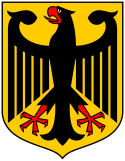Królestwo Niemieckie
| 962–1806[a] | |
 | |
| Język urzędowy | |
|---|---|
| Stolica | |
| Ustrój polityczny | |
| Typ państwa | |
| Status terytorium | |
| Zależne od | |
| Przekształcenie się z Królestwa wschodniofrankijskiego | |
| • postępująca defragmentacja królestwa • (oficjalnie) decyzja Franciszka II | XII-XIV wiek |
| Religia dominująca | |
| Terytoria zależne | |
| Niemcy w 962 r. | |
Królestwo Niemieckie (łac. Regnum Teutonicum, niem. Königreich Deutschland) – średniowieczne i nowożytne państwo na terenie dzisiejszych Niemiec, Austrii, Holandii, Belgii, Luksemburga, Słowenii oraz częściowo Szwajcarii i Francji. Instytucjonalnie tożsame z Królestwem wschodniofrankijskim – nazwę Królestwo Niemieckie stosuje się dla epoki po wymarciu dynastii Karolingów. Od 962 część składowa i rdzeń terytorialny Świętego Cesarstwa Rzymskiego.
Instytucje polityczne Świętego Cesarstwa Rzymskiego i Królestwa Niemieckiego były po roku 962 w zasadzie tożsame. Ustrój i historia obu organizmów pokrywają się w dużej mierze, choć należy pamiętać, że Święte Cesarstwo obejmowało także Włochy i Burgundię. Władca tytułowany był po koronacji przez papieża cesarzem rzymskim, a bez niej od XI wieku – królem Rzymian (Rex Romanorum). Od czasu Maksymiliana I każdy wybrany władca stawał się od razu cesarzem, a wybranego za jego życia następcę tytułowano królem Rzymian.
W epoce nowożytnej nastąpiło utożsamienie Świętego Cesarstwa z państwem niemieckim i nazwa Królestwo Niemieckie praktycznie wyszła z użycia, chociaż cesarze używali konsekwentnie obu tytułów. Stąd zamienne stosowanie pojęć Święte Cesarstwo Rzymskie i Rzesza Niemiecka.
Instytucjonalny kres Królestwa Niemieckiego nastąpił w 1806 kiedy, po secesji kilkunastu księstw i klęsce Austriaków w bitwie pod Austerlitz, ostatni cesarz rzymski i król niemiecki Franciszek II ogłosił rozwiązanie Świętego Cesarstwa Rzymskiego.
Uwagi
- ↑ Formalnie Królestwo Niemieckie było częścią Świętego Cesarstwa Rzymskiego, nigdy nie ogłoszono jego likwidacji, ale od wielkiego bezkrólewia władza królewska zaczęła stawać się coraz bardziej iluzoryczna, a władza na poszczególnych terytoriach należała do lokalnych władców. Złota Bulla Karola IV nadała elektorom praktyczną niezależność od władzy centralnej. Pojęcia Królestwa Niemieckiego i Cesarstwa jeszcze w późnym średniowieczu zlały się ze sobą, a tytuły króla i cesarza były przez władców traktowane łącznie.
- ↑ Brak stałej siedziby władcy i nominalnej stolicy. Akwizgran był tradycyjnym miejscem koronacji władców i dawną rezydencją Karola I Wielkiego.
Bibliografia
- Averkorn R., The Process of Nationbuilding in Medieval Germany. A Brief Overview.
- Bernhardt, J. W., Itinerant Kingship and Royal Monasteries in Early Medieval Germany, c. 936–1075. Cambridge: Cambridge University Press, 1993.
- Beumann H., "Die Bedeutung des Kaisertums für die Entstehung der deutschen Nation im Spiegel der Bezeichnungen von Reich und Herrscher", in Nationes, 1 (1978), pp 317–366.
- Fuhrmann H., "Quis Teutonicos constituit iudices nationum? The Trouble with Henry." Speculum, Vol. 69, No. 2. (Apr., 1994), pp 344–358.
- Gillingham J., The Kingdom of Germany in the High Middle Ages (900–1200). Historical Association Pamphlets, General Series, no. 77. London: Historical Association, 1971.
- Gillingham J., "Elective Kingship and the Unity of Medieval Germany". German History, 9:2 (1991:June), pp. 124–135.
- MacLean S., Kingship and Politics in the Late Ninth Century: Charles the Fat and the end of the Carolingian Empire. Cambridge University Press: 2003.
- Mierow Ch. Ch., The Two Cities: A Universal Chronicle to the Year 1146 A.D., by Otto, Bishop of Freising, (Records of Western Civilization), New York: Columbia University Press, 2002.
- Mitchell O. C., Two German Crowns: Monarchy and Empire in Medieval Germany. Lima, Ohio: Wyndham Hall Press, 1985.
- Reindal R., "Herzog Arnulf und das Regnum Bavariae", in Zeitschrift für bayerische Landesgeschichte, 17 (1954), pp 187–252.
- Timothy R., Germany in the Early Middle Ages, c. 800–1056. Longman, 1991.
- Reynolds S., Kingdoms and Communities in Western Europe, 900–1300, 2nd Ed., Oxford, 1997.
- Robinson, I. S., "Pope Gregory VII, the Princes and the Pactum 1077–1080." The English Historical Review, Vol. 94, No. 373. (Oct., 1979), pp 721–756.
- Thompson J. W., Feudal Germany. 2 vol. New York: Frederick Ungar Publishing Co., 1928.
Media użyte na tej stronie
Autor:
-
Blank map of Europe.svg: maix¿?
- derivative work: Alphathon
A map of the Kingdom of Germany within the Holy Roman Empire and within Europe circa 1004 CE, after the incorporation of the Duchy of Bohemia. The main subdivisions of the Byzantine Empire, Holy Roman Empire, Burgundy, France and Poland are also shown. The pale green territory to the south is the Kingdom of Italy, which was also part of the Empire.
Autor: Jaume Ollé; svg version by Masur, Licencja: CC-BY-SA-3.0
Reconstruction of the flag used by the German kings in the later medieval period (c. 12th to 14th centuries).
The existence of such a flag is certain for the 14th century, likely for the 13th century, and uncertain for the 12th century. It was used by emperor Henry VII in his Italian campaigns, and is repeatedly depicted in this context in Codex Balduini Trevirensis (c. 1340). In the Kassel Willehalm Codex (c. 1336), the same flag is (anachronistically) shown in a battle scene of Charlemagne.
According to Meyers Konversations-Lexikon of 1897 (s. v. "Banner"), the German Imperial Banner since the time of Sigismund (1430s), and "perhaps earlier" showed the Imperial Eagle, viz. a double-headed black eagle in a yellow field.
The banner used by some of the German kings or emperors of the late 12th and early 13th century may have shown an eagle, in the case of Otto IV an "eagle hovering over a dragon".Autor: Ramsay Muir, Licencja: CC BY-SA 4.0
Mapa zobrazuje jednotlivá kmenová vévodství Německa k roku 962.





